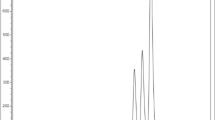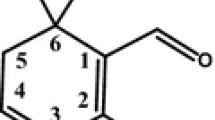Abstract
In this work, methyl β-cyclodextrin (Mβ-CD) was used to increase the solubility of turmeric rhizome oleoresin (TRO) in aqueous solution by forming inclusion complexes, and the technique was combined with microwave-assisted extraction (MAE) to extract the curcuminoids from Curcuma domestica Val. Optimized conditions for the MAE were microwave power of 700 W, extraction particle size of 0.30–0.60 mm, extraction time of 3 min, solvent volume of 10 mL, 2 g of sample, and extraction temperature of 60 °C. High-performance liquid chromatography was used for the determination of the curcuminoids. Phase solubility study was conducted to investigate the association of Mβ-CD with TRO using curcumin, the major curcuminoid, as a marker compound to represent turmeric oleoresin. The curcumin recovery was increased due to its complexation with Mβ-CD. Linear host–guest correlation with slope of <1 indicated a stoichiometry of 1:1 Mβ-CD-complex, and with this assumption, the stability constant, K C , was calculated as 515.19 M−1. Meanwhile, the molar ratio needed for inclusion complexation between TRO/Mβ-CD was 1:2. Attenuated total reflectance Fourier transform infrared spectroscopy results revealed that the MAE application for the co-precipitation, physical, and kneading methods can all be used for complexation.








Similar content being viewed by others
References
Al-Harahsheh M, Kingman SW (2004) Microwave-assisted leaching: a review. Hydrometallurgy 73:189–203
Anand P (2008) Biological activities of curcumin and its analogues (congeners) made by man and Mother Nature. Biochem Pharmacol 76:1590–1611
Arias M, Garcia-Rio L, Mejuto JC, Rodriguez-Dafonte P, Simal-Gandara J (2005) Influence of micelles on the basic degradation of carbofuran. J Agric Food Chem 53:7172–7178
Arias-Estevez M, Fernandez-Gandara D, Garcia-Falcon MS, Garcia-Rio L, Mejuto JC, Simal-Gandara J (2007) Sorption of PAHs to colloid dispersions of humic substances in water. Bull Environ Contam Toxicol 79:251–254
Astray G, Gonzalez-Barreiro C, Mejuto JC, Rial-Otero R, Simal-Gandara J (2009) A review on the use of cyclodextrins in foods. Food Hydrocoll 23:1631–1640
Astray G, Mejuto JC, Morales J, Rial-Otero R, Simal-Gandara J (2010) Factors controlling flavors binding constants to cyclodextrins and their applications in foods. Food Res Int 43(4):1212–1218
Baglole KN, Boland PG, Wagner BD (2005) Fluorescence enhancement of curcumin upon inclusion in to parent and modified cyclodextrins. J Photochem Photobiol A Chem 173:230–237
Chen JJ, Tsai CS, Hwang TL, Shieh PC, Chen JF, Sung PJ (2010) Sesquiterpenes from the rhizomes of Curcuma longa with inhibitory activity on superoxide generation and elastase release by neutrophils. J Food Chem 199:974–980
Cid A, Mejuto JC, Orellana PG, Lopez-Fernandez O, Rial-Otero R, Simal-Gandara J (2013) Effects of ascorbic acid on the microstructure and properties of SDS micellar aggregates for potential food applications. Food Res Int 50(1):143–148
Cid A, Morales J, Mejuto JC, Briz-Cid N, Rial-Otero R, Simal-Gandara J (2014) Thermodynamics of sodium dodecyl sulphate–salicylic acid based micellar systems and their potential use in fruits postharvest. Food Chem 151:358–363
Eskilsson CS, Bjorklund E (2000) Analytical-scale microwave-assisted extraction. J Chromatogr A 902:227–250
Garcia-Zubiri I, Gonzalez-Gaitano G, Sanchez M, Isasi JR (2003) FTIR study of dibenzofuran-2-carboxylic acid and its complexes with β-cyclodextrins. Vib Spectrosc 33:205–213
Hegge AB, Andersen T, Melvik JE, Kristensen S, Tønnesen HH (2010) Evaluation of novel alginate foams as drug delivery systems in antimicrobial photodynamic therapy (aPDT) of infected wounds—an in vitro study: studies on curcumin and curcuminoids XL. J Pharm Sci 99(8):3499–3513
Higuchi T, Connors KA (1965) Phase solubility techniques. Adv Anal Chem Instrum 4:117–122
Himanshu M, Darshana M, Mehta BK, Jain DC (2013) Microwave-assisted extraction studies of target analyte artemisinin from dried leaves of Artemisia annua L. Org Chem Int. doi:10.1155/2013/163028
Joshi U, Mane V, Joshi SV (2009) Comparative study of conventional and microwave assisted extraction of some indigenous drugs. Res J Pharm Tech 2(2):417–418
Lemos MA, Aliyu MM, Hungerford G (2012) Observation of the location and form of anthocyanin in purple potato using time-resolved fluorescence. Food Sci Emerg Technol 16:61–68
Loftsson T, Brewster ME (1996) Pharmaceutical applications of cyclodextrins on drug solubilisation and stabilisation. J Pharm Sci 85(10):1017–1025
Lopez-Fernandez O, Rial-Otero R, Cid A, Simal-Gandara J (2014) Combined determination and confirmation of ethylenethiourea and propylenethiourea residues in fruits at low levels of detection. Food Chem 145:1002–1010
Mari’a TM-R, Carmen L-A, Jose AG, Maria IF, Adela M-C, Estrella N-D (2010) Kaempferol complexation in cyclodextrins at basic pH. J Agric Food Chem 58:4675–4680
Mukne AP, Nagarsenker MS (2004) Traimterene-β-cyclodextrin systems preparation characterization and in vivo evaluation. AAPS PharmSciTech 5(1):1–9
Nishiyama T, Mae T, Kishida H, Tsukagawa M, Mimaki Y, Kuroda M (2005) Curcuminoids and sesquiterpenoids in turmeric (Curcuma longa L.) suppress an increase in blood glucose level in type 2 diabetic kk-A+ mice. J Agric Food Chem 53:959–963
Qureshi S, Shah AH, Ageel AM (1992) Toxicity studies on Alpinia galanga and Curcuma longa. Planta Med 58:124–127
Rajeswari C, Alka A, Javed A, Khar RK (2005) Cyclodextrins in drug delivery. AAPS PharmSciTech 6(2):43
Richardson JF, Harker JH (2002) Particle technology and separation processes, 5th edn. Butterworth-Heinemann, Oxford
Szejtli J (1998) Introduction and general overview of cyclodextrin chemistry. Chem Rev 98:1743–1753
Tonnesen HH, Masson M, Loftsson T (2002) Studies of curcumin and curcuminoids. XXVII. Cyclodextrin complexation: solubility, chemical and photochemical stability. Int J Pharm 244:127–135
Vivek RY, Sarasija S, Kshama D, Seema Y (2009) Effect of cyclodextrin complexation of curcumin on its solubility and antiangiogenic and anti-inflammatory activity in rat colitis model. AAPS Pharm Sci Technol 10(3):752–762
Vivekananda M, Yogesh M, Hemalatha S (2007) Microwave assisted extraction—an innovative and promising extraction tool for medicinal plant research. Pharmacogn Rev 1(1):7–18
Waleczek KJ, Marques C, Hempel B, Schmidt PC (2003) Phase solubility study of pure (−)-α-bisabolol and camomile essential oil with β-cyclodextrin. Eur J Pharm Biopharm 55:247–251
Zaibunnisa AH, Saim N, Said M, Illias R, Wan A, Hassan O (2009) Characterisation of cyclodextrin complexes with turmeric oleoresin. J Food Chem 114:459–465
Zaibunnisa AH, Siti RR, Nur Ain AH (2011) Stabilisation of curcumin with γ-cyclodextrin: phase solubility study and its characterization. 2nd International Conference of Biotechnology and Food Science, Bali Island, Indonesia, abstract book, pp 9–13
Zhang A, Liu W, Wang L, Wen Y (2005) Characterization of inclusion complexation between fenoxaprop-p-ethyl and cyclodextrin. J Agric Food Chem 53(18):7193–7197
Acknowledgments
The authors thank Universiti Teknologi Malaysia and the Ministry of Education, Malaysia (MOE), for facilitations and financial support through Grant No. [Q.J130000.2526.03H79].
Conflict of Interest
Binta Jume Hadi declares no conflict interest. Mohd Marsin Sanag declares no conflict interest. Hassan Y. Aboul-Enein declares no conflict interest. Wan Aini Wan Ibrahim declares no conflict interest. Shajarahtunnur Jamil declares no conflict interest. Mohammed Abdullahi Mu’az declares no conflict interest. The authors declare that this study does not involve human or animals.
Author information
Authors and Affiliations
Corresponding authors
Rights and permissions
About this article
Cite this article
Hadi, B.J., Sanagi, M.M., Aboul-Enein, H.Y. et al. Microwave-Assisted Extraction of Methyl β-Cyclodextrin-Complexed Curcumin from Turmeric Rhizome Oleoresin. Food Anal. Methods 8, 2447–2456 (2015). https://doi.org/10.1007/s12161-015-0137-3
Received:
Accepted:
Published:
Issue Date:
DOI: https://doi.org/10.1007/s12161-015-0137-3




